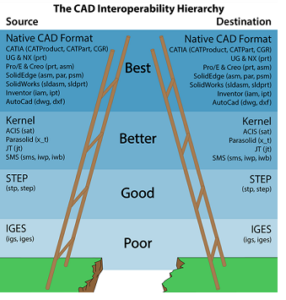Selecting the Best 3D Format for Exchange
TransMagic Onboarding: Lesson 5 of 7
(to see all of the Onboarding lessons, click here)
Here is the basic priority, starting with the highest quality:
- Native
- Kernel
- STEP
- IGES
Native
If the originating CAD system is Creo(Pro/E), UG/NX, CATIA V4\V5\V6, SOLIDWORKS, SolidEdge, Inventor, or Microstation then ask for their native file. With TransMagic, now YOU can support these formats.
Here is even better news, you don’t have to worry about the version, Transmagic figures that out for you.
Kernel Formats
The next best thing to the native formats are the kernel formats. TransMagic supports ACIS, Parasolid, and SMLib. The majority of 3D CAM-CAM-CAE applications are based on ACIS & Parasolid.
Applications like KeyCreator (CADKEY), MasterCAM and Ansys are based on ACIS. Visi, SOLIDWORKS, NX, and GibbsCAM use Parasolid for example. SMLib is used by Zemax, Allplan and several others.
STEP vs. IGES
Both formats are open standards and are not proprietary. Therefore they are often the default for exchanging 3D data. Beware of IGES files! Why? Because you will lose detailed information that would most likely be included in the native or kernel formats. Often the geometry is incomplete.
STEP is a 3D format for solid models. However, IGES files are usually just surfaces.
So…use STEP if no other solid format is available (native or kernel).
And…use IGES as your last resort. If you must use IGES, see if your customer/vendor has the option to write out an IGES file as an MSBO (Manifold Solid Boundary Object). This option is not often available in most IGES writers but if it is, it’s at least a solid IGES format. The best IGES reader in the world can’t help if the IGES writer created a terrible IGES file. Unfortunately, this is very often the case.
Finally, consider the target application and use the same methodology of native file formats
Go
End of Lesson 5 – Selecting the Best 3D Format for Exchange
Thanks for taking the time to review this lesson. If you have questions, please email us at support@transmagic.com or reach out to us via chat from transmagic.com.
This is lesson 5 of 7 of the introductory on-boarding series for TransMagic. Visit TransMagic On-Boarding for a list of all the lessons.
Please feel free to share this lesson with others in your company. They can get their own trial by visiting this page TransMagic.com/get-a-trial.

